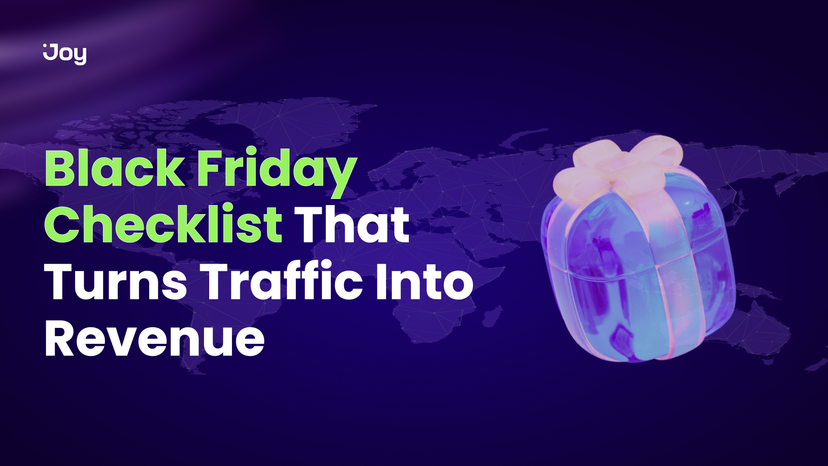Loyalty programs are not just about handing out points and hoping for the best. They’re a strategic investment, and like any investment, you need to know if it’s paying off.
Many businesses launch rewards programs with great enthusiasm, only to struggle with measuring their true impact. Are you getting a strong return on investment (ROI), or is your program draining resources without delivering results?
In this guide, we’ll break down the essentials of calculating your loyalty program ROI, from key metrics to track to common pitfalls to avoid along with proven strategies to optimize performance.
Let’s dive in!
What is the ROI of A Loyalty Program?
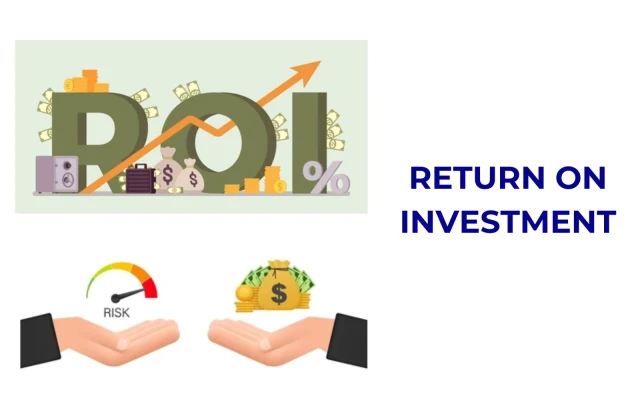
The Return on Investment (ROI) of a loyalty program measures how much revenue or profit is generated from the program relative to the costs involved in running it. Essentially, it tells you whether your loyalty program is paying off and contributing to your bottom line.
Loyalty programs contribute to a company’s ROI through both direct and indirect avenues:
Direct contributions
- Enhanced customer retention: Loyalty programs incentivize repeat business, reducing the need for costly customer acquisition efforts. Studies show that increasing customer retention by 5% can boost profits by 25-95%.
- Increased purchase frequency: Members often buy more frequently to earn rewards, boosting sales volume.
- Higher spend per transaction: Exclusive offers encourage members to spend more during each visit.
Indirect contributions
- Customer referrals: Satisfied loyalty program members are inclined to refer friends and family, expanding the customer base without significant marketing expenses.
- Valuable customer insights: Data collected from program interactions helps tailor marketing strategies and product offerings.
- Competitive differentiation: A well-designed program can distinguish a brand in a crowded market, attracting customers seeking added value.
As a business owner, you must have noticed that several elements can significantly impact the effectiveness and ROI of a loyalty program:
- Program structure: The design of the program, such as the ease of earning and redeeming rewards, plays a crucial role in customer participation and satisfaction.
- Customer experience: Providing exceptional service and personalized experiences can strengthen customer loyalty and increase program engagement.
- Market conditions: Economic shifts and competitive actions can affect customer participation and perceived value.
- Technological integration: Utilizing technology to track data on customer behavior and preferences can significantly impact program effectiveness.
- Employee engagement: Employees who are satisfied and engaged are more likely to deliver superior customer service, which in turn fosters customer loyalty and positively affects the program’s success.
How to Calculate ROI for Your Loyalty Program
To begin, it’s essential to pinpoint the critical metrics that will serve as the foundation for your ROI analysis:
- Customer Lifetime Value (CLV): Estimate the total revenue a business can expect from a customer over the entire duration of their relationship.
First, compare how often loyalty program members buy and how much they spend compared to customers who aren’t members. This will give you a general idea.
But to really see if the loyalty program is the reason behind their loyalty, you need to incentivize actions that aren’t directly related to buying. For example, make a coupon available only if a customer downloads and uses a dedicated loyalty app. This proves they’re engaging with the program specifically, not just buying as they normally would.
- Average Order Value (AOV): Determine the average amount spent each time a loyalty member makes a purchase. Effective programs often see an increase in AOV, as members are incentivized to spend more to earn greater rewards.
- Repeat Purchase Rate: Assess the frequency with which loyalty members make repeat purchases within a specific timeframe. A higher repeat purchase rate signifies stronger customer loyalty and program success.
- Redemption Rate: Measure the percentage of earned rewards that customers actually redeem. A higher rate suggests that members find the rewards valuable and are actively engaged with the program.
- Customer Acquisition Cost (CAC): Calculate the average expense incurred to attract a new customer who joins your loyalty program. This includes marketing campaigns, promotions, and any incentives offered to encourage sign-ups.
- Program Costs: Compile all expenses related to the loyalty program, including costs for rewards, technology platforms, marketing efforts, and administrative support.
With these metrics in hand, you can employ various methodologies to calculate the ROI of your loyalty program:
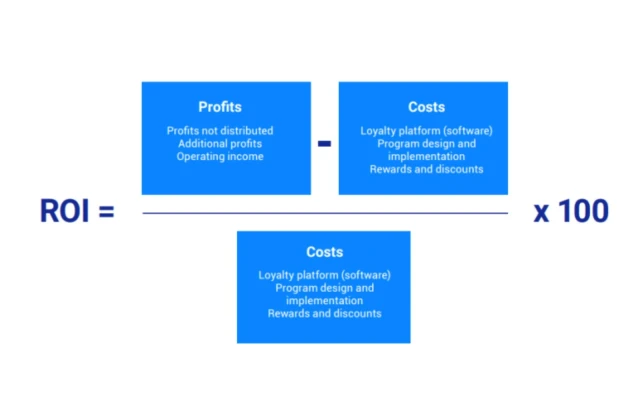
- Simple ROI Formula: This straightforward approach compares the profit generated by the loyalty program to its total costs, indicating how much return is earned per dollar spent on the program.ROI = (Gross Profit − Program Costs) / Program Costs×100%
Example: If your loyalty program yields a gross profit of $500,000 and incurs costs of $200,000, the ROI would be: (500,000-200,000)/200,000 ×100%=150%
- CLV-based ROI: This method focuses on the difference in CLV between loyalty program members and non-members, relative to program costs:ROI = (CLVMembers − CLVNon-Members − Program Costs) / Program Costs)×100%
A higher CLV difference means the program successfully drives customer retention and increased spending.
Example: If the CLV of loyalty program members is $1,500, the CLV of non-members is $1,000, and the program costs amount to $250,000, with 2,000 members:
Incremental CLV = $1,500−$1,000 = $500
Total Incremental CLV = $500×2,000 = $1,000,000
ROI = (1,000,000−250,000)/250,000×100% = 300%
Benchmarks for Evaluating Loyalty Program Performance
To determine if a loyalty program is performing well, consider the following industry benchmarks:
- ROI expectations: Approximately 75% of companies report a positive return on investment from their loyalty programs, with some brands achieving an 8.5x ROI within 90 days of implementation.
- Repeat purchase rate: Loyalty program members often exhibit a 12-18% higher repeat purchase rate compared to non-members, reflecting improved customer retention.
- Customer spend: Loyal customers tend to spend 67% more than new ones, highlighting the financial benefits of effective loyalty initiatives.
It is recommended to regularly compare your program’s metrics against these benchmarks, helping identify areas for improvement and ensuring that your loyalty initiatives are driving desired outcomes.
Common Challenges in Measuring Loyalty Program ROI
Unpreventably, measuring the ROI of loyalty programs presents several challenges that can obscure their true effectiveness. Understanding these obstacles is essential for implementing strategies to assess and enhance program performance.
- Attribution Issues
One significant challenge is linking sales directly to the program, especially when other marketing efforts are simultaneously influencing customer behavior. This complexity can lead to underestimating the program’s actual impact.
Solutions
- A/B testing: Implementing control groups that do not participate in the loyalty program allows for comparison against active members, helping to isolate the program’s effect on sales.
- Customer surveys: Gathering direct feedback from customers can provide insights into their motivations and the program’s influence on their purchasing decisions.
- Delayed ROI realization
Loyalty programs are often a long-term investment, and it may take time to see a significant return. Businesses may become impatient if they don’t see immediate results, leading to premature program changes or abandonment.
- Setting realistic timelines: Communicate to stakeholders that loyalty programs are strategic investments with benefits that accrue over time.
- Focus on leading indicators: Track metrics like participation rate, engagement, and redemption rate, which can indicate future success.
- Regularly review and adjust: Continuously monitor your program’s performance and make data-driven adjustments to optimize its effectiveness over time.
- Hidden costs and inefficiencies
Beyond apparent costs like discounts and rewards, loyalty programs may incur hidden expenses, including administrative overhead, technology maintenance, and data management. Overlooking these can lead to an overestimation of the program’s profitability.
Ways to Optimize Costs
- Comprehensive cost analysis: Regularly audit all expenses associated with the program to identify and address inefficiencies.
- Technology investment: Use advanced loyalty program software that offers comprehensive reporting capabilities, enabling precise tracking and optimization of program costs.
5 Strategies to Improve And Maximize Your Loyalty Program ROI
Below are five high-impact strategies to improve loyalty program effectiveness and drive sustainable business growth.
Enhancing customer engagement for higher returns: Deepening customer engagement is indispensable to increasing the success of your loyalty program. Two effective methods to achieve this are:
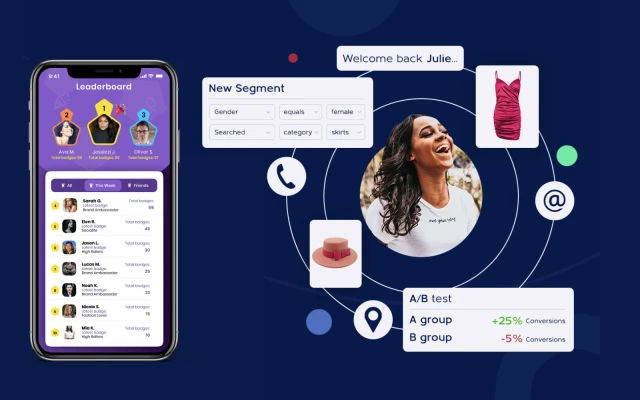
- Personalization and data-driven rewards: Utilizing customer data to tailor rewards and communications ensures that offerings resonate with individual preferences, fostering a stronger connection to your brand.
Ulta Beauty’s loyalty program leverages personalized incentives, contributing to 96% of its sales through its 43.3 million members. - Leveraging gamification and exclusive benefits: Incorporate gamified elements and offer exclusive perks to make the loyalty experience more engaging.
Domino’s Pizza’s “Emergency Pizza” promotion is a prime example, where members received a free pizza after a qualifying purchase, leading to the addition of two million new loyalty members and a boost in sales.
- Reducing costs without hurting program effectiveness: Maintaining a cost-effective loyalty program without compromising its value is essential. Consider the following approaches:
- Choosing cost-effective rewards: Offering rewards that are valuable to customers but economical for the company can maintain satisfaction while controlling expenses.
Starbucks’ loyalty program increased customer visits by 26% through personalized rewards, demonstrating that thoughtful reward selection can drive engagement without excessive costs.
- Optimizing automation and reducing operational expenses: Implementing automated systems for reward distribution and customer tracking can streamline operations, reduce administrative costs, and minimize human error.
- Increasing CLV Through Loyalty Programs: Enhancing the CLV of your customers directly impacts your program’s ROI.
- Upselling and cross-selling strategies: Encouraging existing customers to purchase higher-end products or complementary items can boost their overall value.
- Driving higher purchase frequency with targeted incentives: Providing timely and relevant incentives encourages customers to shop more frequently, increasing their overall spending.
Implementing tiered loyalty structures

People may love to conquer! Creating a tiered loyalty program can motivate customers to increase their engagement and access to higher levels of benefits. This structure not only incentivizes more frequent purchases but also fosters a sense of exclusivity and achievement.
Utilizing data analytics for continuous improvement: Leveraging data analytics in such a digital world nowadays is a superior advantage that can drive ongoing enhancements in your loyalty program.
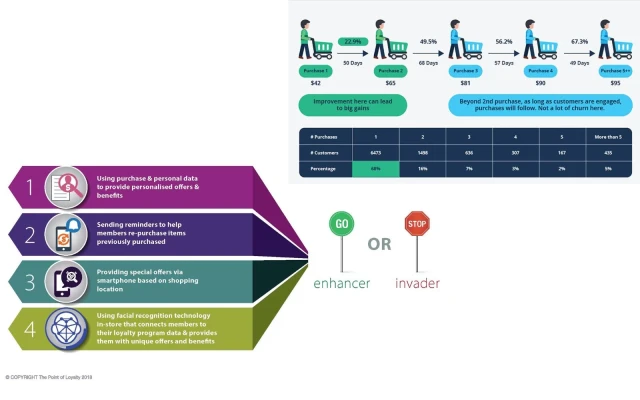
- Monitoring customer behavior: Analyze customer interactions and purchasing patterns to refine program offerings and address emerging needs. It is highly recommended that external tools, especially the development of AI, be leveraged to approach as much data as possible.
- Adjusting strategies based on insights: Use data-driven insights to adapt and optimize your loyalty initiatives, ensuring they remain effective and aligned with customer expectations
Other Metrics Other Than ROI To Keep An Eye On
Apart from critical metrics to measure the success of a loyalty program like ROI, there are also several other metrics that offer valuable insights into customer behavior and program effectiveness.

Key among these are:
- Customer engagement metrics: These metrics assess the level of interaction and involvement customers have with a brand, reflecting their interest and commitment. High engagement levels often correlate with increased loyalty and a higher lifetime value.
Key indicators:
- Click-through rate (CTR): The percentage of customers who click on a specific link or call to action in communications.
- Time spent on site: The average duration customers spend on the company’s website, indicating content relevance and engagement.
- Social media interactions: The number of likes, shares, comments, and mentions on social platforms reflects brand resonance.
- Churn rate: The percentage of customers who discontinue their relationship with a company over a specific period.
Formula:
Churn Rate = (Number of Customers Lost During Period / Number of Customers at Start of Period) × 100
A high churn rate indicates potential issues with customer satisfaction or product/service quality. Reduced churn is essential for maintaining a stable customer base and ensuring sustainable revenue growth.
- Net Promoter Score (NPS): A metric that gauges customer loyalty by measuring their willingness to recommend a company’s products or services to others.
Calculation:
- Survey question: Customers are asked, “How likely are you to recommend our company/product/service to a friend or colleague?” on a scale of 0 to 10.
- Categorization:
- Promoters: Respondents scoring 9 or 10.
- Passives: Respondents scoring 7 or 8.
- Detractors: Respondents scoring 0 to 6.
- NPS Formula: NPS = %Promoters−%Detractors
NPS would range from -100 to +100. A positive score suggests more promoters than detractors, indicating good customer loyalty. Conversely, a negative score highlights a need for improvement in customer satisfaction.
How To Effectively Track Loyalty Program ROI
Measuring the ROI requires more than just tracking revenue. Businesses need robust analytics, automation, and real-time insights to ensure their programs are both cost-effective and impactful.
The right software solutions help streamline this process, making it easier to track customer engagement, retention, and profitability.
Currently, among the most innovative apps on the market, Joy Loyalty goes a step further by combining ease of use with deep analytics. Its outstanding features of real-time analytics, data visualization, and other multiple essentials for loyalty programs can help brands craft highly personalized, data-driven reward programs.
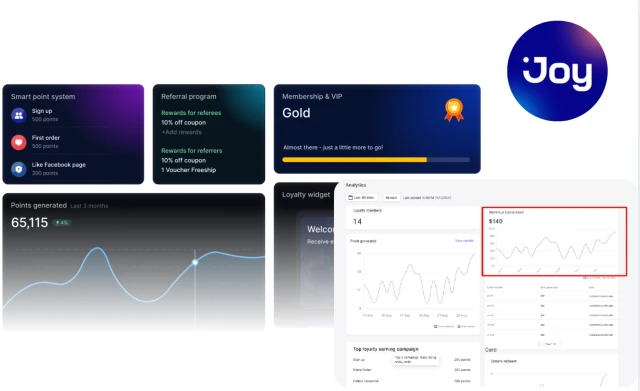
At the end of the day, tracking loyalty program ROI is an ongoing process that requires careful planning, implementation, and analysis. By defining clear objectives, leveraging the right tools, and continuously optimizing your program, you can ensure it delivers a significant return on your investment and contributes to your business’s long-term success.
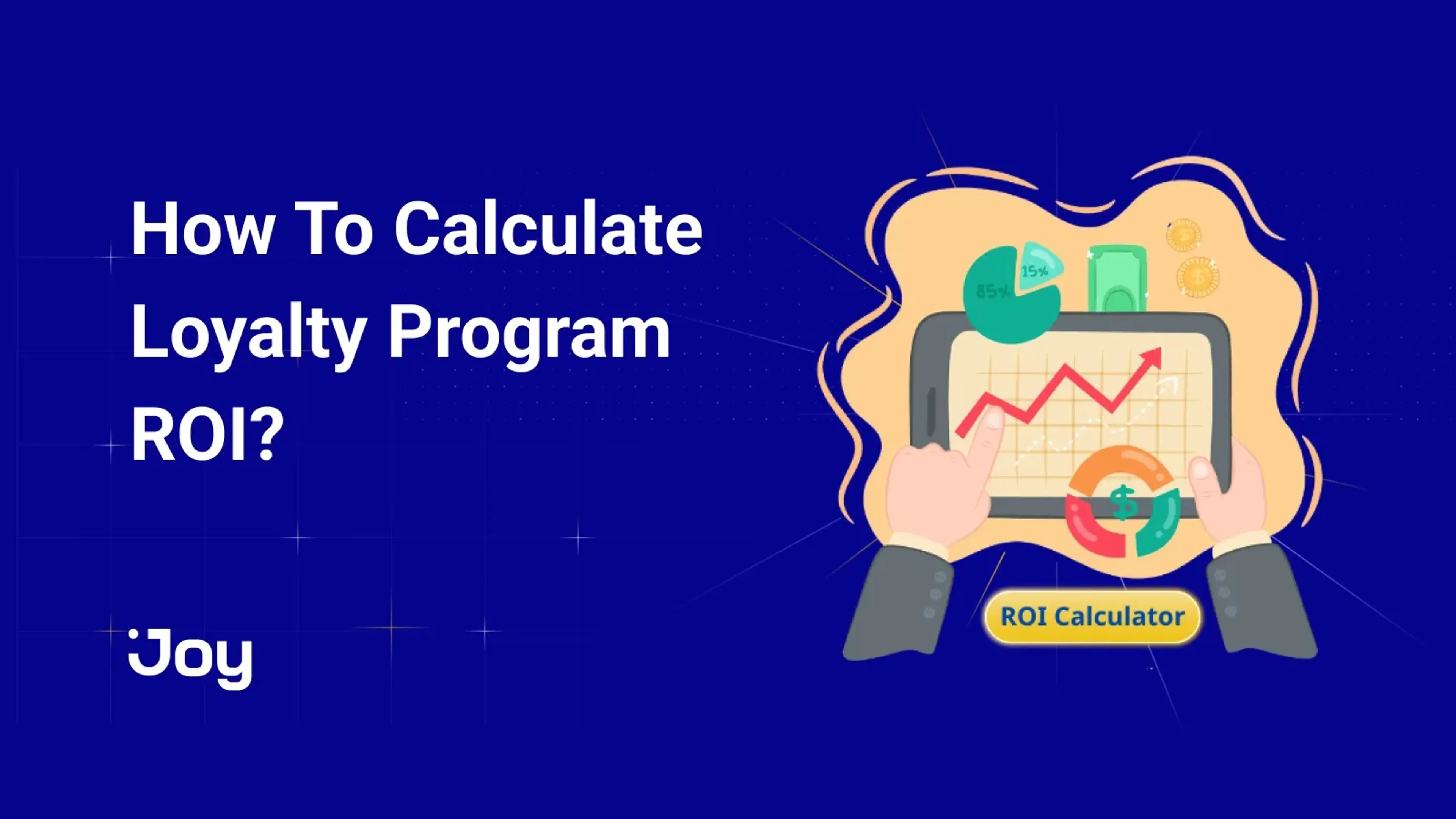


-a7e9a3.png?width=828&q=75&f=webp&auto=format)
